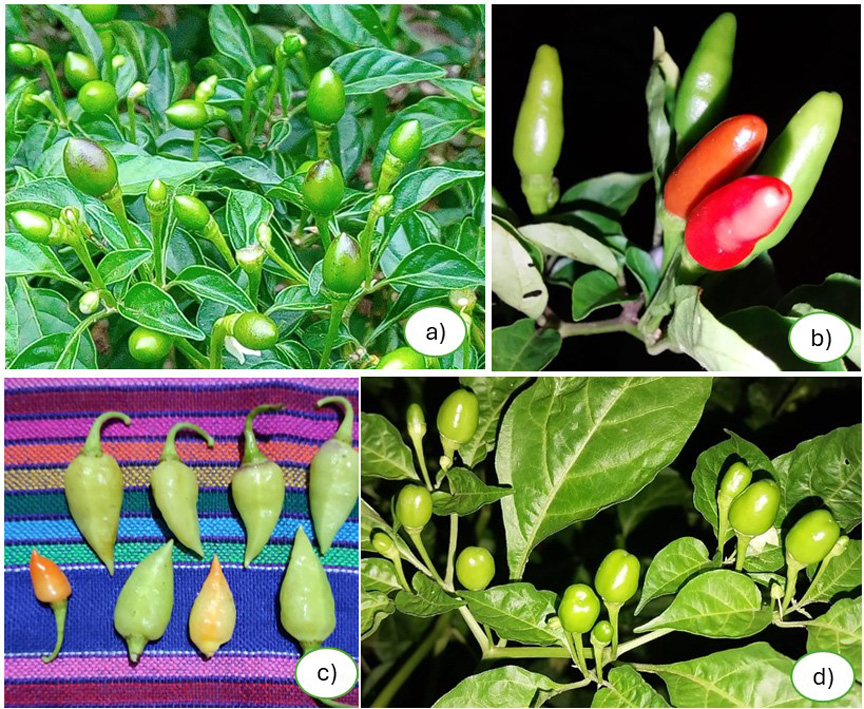Ethnobotany of wild chili peppers in two ch’ol communities of Tacotalpa, Tabasco, Mexico
DOI:
https://doi.org/10.18387/polibotanica.60.26Keywords:
Culture, Diversity, Management, BioculturalAbstract
Forty-three species belonging to the genus Capsicum have been identified, of which only five have been domesticated, while the rest are considered strictly wild. These wild species represent a valuable local resource deeply rooted in culture, as their conservation and use are intrinsically linked to rural and Indigenous communities. Ethnobotanical studies enable the recovery of knowledge associated with the management of plant species to develop conservation strategies for these resources. The objective of this research was to identify the biotypes, uses, and management of wild chili peppers in the Sierra de Tabasco. The study was conducted in two ch’ol communities in the municipality of Tacotalpa, employing structured and semi-structured interviews as well as community surveys. Eight types of chili peppers corresponding to two species (C. annuum and C. frutescens) were identified, with the most well-known and consumed being amashito, picopaloma, blanco, and garbanzo. While primarily consumed as food, these chiles are also attributed to medicinal and ritual uses. The consumption of wild chili peppers, particularly in sauces, persists due to cultural ties, and preparation methods vary depending on the type of chili peppers: amashito and picopaloma are usually roasted, while blanco and garbanzo are used fresh. Post-harvest management shows limited practices of pickling or drying fruits. According to interviews, wild chili peppers face the risk of disappearing due to the destruction of their natural habitat. Although some farmers create seedbeds to propagate the plants, these chiles are generally considered to grow spontaneously. Chili peppers play an integral role in the daily life and culture of the ch’ol communities of Tacotalpa and are a highly versatile resource, making it essential to implement conservation actions and sustainable management practices.
References
Aguilar-Meléndez, A., Vásquez-Dávila, M. A., Manzanero-Medina, G. I., & Katz, E. (2021). Chile (Capsicum spp.) as Food-Medicine Continuum in Multiethnic Mexico. Foods, 10(10). https://doi.org/10.3390/foods10102502
Balderas Quezada, K. I., Piña Ramírez, F. J., García Muñoz, S. A., Soto Parra, J. M., & Yáñez Muñoz, R. M. (2023). Chile Piquín (Capsicum annuum var. Glabriusculum) Tesoro Picante de la Naturaleza. Revista Biológico Agropecuaria Tuxpan, 11(2), 18–23. https://doi.org/10.47808/revistabioagro.v11i2.485
Barboza, G. E., García, C. C., Bianchetti, L. de B., Romero, M. V, & Scaldaferro, M. (2022). Monograph of wild and cultivated chili peppers (Capsicum L., Solanaceae). PhytoKeys, 200, 1–423. https://doi.org/10.3897/phytokeys.200.71667
Bernstein, J. A., Davis, B. P., Picard, J. K., Cooper, J. P., Zheng, S., & Levin, L. S. (2011). A randomized, double-blind, parallel trial comparing capsaicin nasal spray with placebo in subjects with a significant component of nonallergic rhinitis. Annals of Allergy, Asthma & Immunology, 107(2), 171–178. https://doi.org/10.1016/j.anai.2011.05.016
Bran, R. A. A., Moya, C., Ponce, P., Álvarez, M., & Varela, M. (2007). Diagnóstico participativo de las condiciones socioculturales asociadas a la conservación de los chiles silvestres (Capsicum Spp.) en la Depresión Central de Chiapas, México. Cultivos Tropicales, 28(1), 69–73. https://www.redalyc.org/articulo.oa?id=193215858012
Castañón-Nájera, G., Latournerie-Moreno, L., Mendoza-Elos, M., Vargas-López, A., & Cárdenas-Morales, H. (2008). Colección y caracterización de Chile (Capsicum spp) en Tabasco, México. Phyton, 77, 189–202. http://www.scielo.org.ar/scielo.php?script=sci_arttext&pid=S1851-56572008000100016&lng=es&tlng=es.
Castellón-Martínez, É., Chávez-Servia, J. L., Carrillo-Rodríguez, J. C., & Vera-Guzman, A. M. (2012). Preferencias de consumo de chiles (Capsicum annuum L.) nativos en los valles centrales de Oaxaca, México. Revista Fitotecnia Mexicana, 35, 27–35. http://www.scielo.org.mx/scielo.php?script=sci_arttext&pid=S0187-73802012000500007&lng=es&tlng=es.
Instituto Nacional de Estadística y Geografía. (2020). Censo de Población y Vivienda 2020. Instituto Nacional de Estadística y Geografía.
Latournerie-Moreno, L., Gutiérrez-Burón, R., Garruña-Hernández, R., Ruiz-Sánchez, E., Lara-Martín, A. R., & Castañón-Nájera, G. (2020). Diversidad fenotípica de chile Amashito de Tabasco y Chiapas, México. Revista Mexicana de Ciencias Agrícolas, 11(3), 649–662. https://doi.org/10.29312/remexca.v11i3.2087
Lina-Manjarrez, P., Gallegos-Tejeda, P., & Morales-Valenzuela, G. (2022). Huertos, solares y agroecología urbana, más allá de la Soberanía Alimentaria. En C. Elizondo & D. Merlín-López (Eds.), Agroecología en México, soberanía alimentaria, saberes, cosmovisión y patrimonio biocultural. Conocimiento, práctica, movimiento y corazón. Tomo II . (1a ed., pp. 433–456). Editorial Chiapaneros, Sociedad Mexicana de Agroecología.
Long-Solís, J. (1998). Capsicum y cultura: la historia del chilli (Fondo de Cultura Económica, Ed.; 2a ed.). https://books.google.com.mx/books?id=_mdEAAAAYAAJ
López Ordaz, P., & Yáñez Fernández, J. (2023). Propiedades farmacológicas del chile (Capsicum) y sus beneficios en la salud humana: Una revisión bibliográfica. LATAM Revista Latinoamericana de Ciencias Sociales y Humanidades, 4(2), 3827–3840. https://doi.org/10.56712/latam.v4i2.873
Luna Ruiz, J., Pérez Chávez, M., Martínez de Anda, J., & Sosa Ramírez, J. (2018). Distribución ecogeográfica del chile silvestre en México y su conservación ex situ. En A. Aguilar-Meléndez, M. A. Vásquez-Dávila, & E. Katz (Eds.), Los chiles que le dan sabor al mundo. IRD Éditions, Universidad Veracruzana. https://doi.org/https://doi.org/10.4000/books.irdeditions.30934.
Martínez Torres, H. L., Montes Hernández, S., Corona Torres, T., & Vibrans, H. (2021). Etnobotánica del chile quipín en seis municipios de Querétaro. En M. A. Dávila Vásquez, A. Aguilar Meléndez, E. Katz, & G. I. Medina Manzanero (Eds.), Chiles en México. IRD Éditions Universidad Veracruzana. https://doi.org/https://doi.org/10.4000/books.irdeditions.45866.
Montes-Hernández, S., Ramírez-Meraz, M., Mendoza-Vilallón, H., Medina-Martínez, T., Morales-Cuén, A., Heredia-García, E., Ramos-Soto, M., López-de-León, R., Estrada-Cardona, A., & Martínez-Torres, H. L. (2006). Conservación y aprovechamiento sostenible de chile silvestre (Capsicum sp, Solanaceae) en México. En P. López-López & S. Montes-Hernández (Eds.), Avances de investigación de la red de hortalizas del SINAREFI (pp. 71–174). Instituto Nacional de Investigaciones Forestales, Agrícolas y Pecuarias.
Morales-Valenzuela, G., & Carrillo-Contreras, J. (2020). Región Biocultural Ch’ol de Tacotalpa, Tabasco. En D. Luque-Agraz, C. Gay, & B. Ortíz-Espejel (Eds.), Complejos Bioculturales de México: Bienestar comunitario en escenario de cambio climático (pp. 303–326). Benemérita Universidad Autónoma de Puebla y Red Temática Sobre Patrimonio Biocultural de México.
Morales-Valenzuela, G., Villegas Ramírez, M. I., & García Hernández, J. J. (2023). Etnobotánica del chile amashito (Capsicum annum var. Glabriusculum) en el ejido Oxolotán, Tacotalpa, Tabasco. En C. Hernández-Hernández & D. Sumano-López (Eds.), Innovaciones científicas y tecnológicas para el desarrollo sostenible de la agricultura (pp. 103–110). INIFAP.
Narez-Jiménez, C. A., Gómez-Vázquez, A., Castañón-Nájera, G., Márquez-Quiroz, C., & Cruz-Hernández, A. (2014). La diversidad morfológica in situ de chiles silvestres (Capsicum spp .) de Tabasco , México. 37(3), 209–215. http://www.scielo.org.mx/scielo.php?script=sci_arttext&pid=S0187-73802014000300005&lng=es&tlng=es.
Nava Hernández, G., Aldasoro Maya, E. M., Perezgrovas Garza, R., & Vera Cortés, G. (2019). Interacciones del ser humano con animales de traspatio: un estudio desde la Etnoveterinaria en Tabasco, México. Nova Scientia, 10, 258–309. https://www.redalyc.org/articulo.oa?id=203359541015
Ruiz Núñez, N., & Vásquez-Dávila, M. (2018). Etnoecología del chile de campo en Guelavía, Oaxaca. En A. Aguilar-Meléndez, M. A. Vásquez-Dávila, E. Katz, & M. R. Colorado Hernández (Eds.), Los chiles que le dan sabor al mundo. IRD Éditions, Universidad Veracruzana. https://doi.org/https://doi.org/10.4000/books.irdeditions.30970.
Tewksbury, J. J., Nabhan, G. P., Norman, D., Suzán, H., Tuxill, J., & Donovan, J. (1999). In situ conservation of wild chiles and their biotic associates. Conservation Biology, 13(1), 98–107. https://doi.org/https://doi.org/10.1046/j.1523-1739.1999.97399.x
Waizel-Bucay, J., & Camacho Morfín, R. (2011). El género Capsicum spp. (“chile”) Una versión panorámica. Aleph Zero, 16(60), 67–79.

Downloads
Published
License
Copyright (c) 2025 POLIBOTANICA

This work is licensed under a Creative Commons Attribution-NonCommercial-ShareAlike 4.0 International License.

Polibotánica by Departamento de Botánica de la Escuela Nacional de Ciencias Biológicas del Instituto Politécnico Nacional se distribuye bajo una Licencia Creative Commons Atribución-NoComercial-CompartirIgual 4.0 Internacional.



















